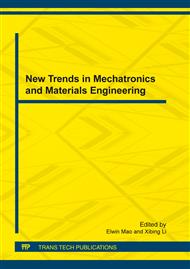p.3
p.7
p.13
p.19
p.23
p.28
p.32
p.36
The Fault Diagnosis Method Based on Wavelet Packet Characteristic Entropy and Relevance Vector Machine
Abstract:
The sensor fault diagnosis method based on wavelet packet characteristic entropy and relevance vector machine are researched, which is used on engine test bed . In detail, the wavelet packet characteristic entropy is applied for feature extraction to get the feature matrix which denote all kinds of known working status of sensor, and the feature matrix are encoded; The feature matrix as inputs and feature codes as outputs are proposed for training the relevance vector machine classifier to get the optimum parameters. In the fault diagnosis unit, it uses the wavelet packet characteristic entropy to acquire the on-line feature matrix of sensor. The on-line feature matrix is supplied to the trained relevance vector machine classifier as inputs to validate the working status of sensor. An application of the method in engine test bed system is introduced. Finally, the applicability and effectiveness of the method is illustrated by experiments
Info:
Periodical:
Pages:
3-6
Citation:
Online since:
January 2012
Authors:
Price:
Сopyright:
© 2012 Trans Tech Publications Ltd. All Rights Reserved
Share:
Citation:


